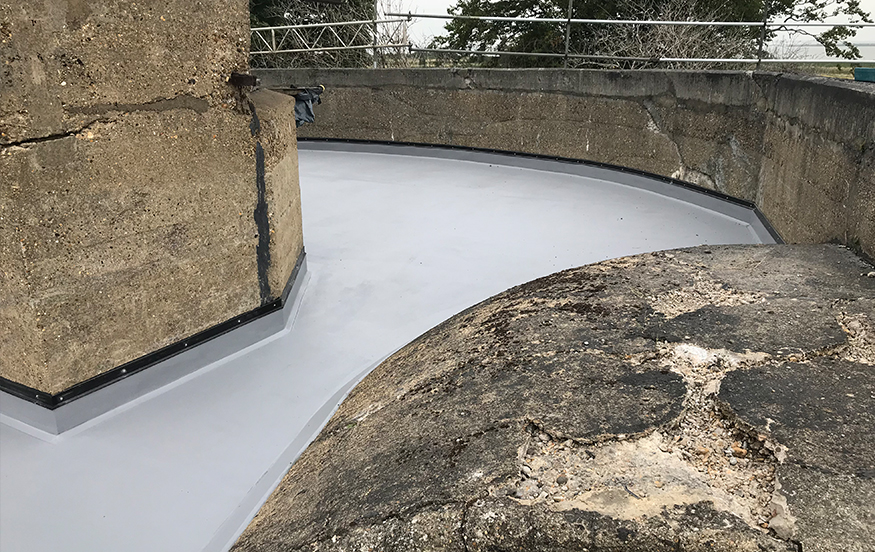Strategically located on the Essex peninsular near East Tilbury, Coalhouse Fort is an artillery fort which was originally built in the 1860’s to help counter the threat of a French invasion. At the time, a defensive wall was constructed around the British Isles to protect from the perceived threat and Coalhouse Fort was built to guard the Thames estuary from seaborne attack. It was also used during World War One and Two before being closed in 1956 following the abolition of coastal defence.
The fort still stands today and it is now one of the most important military sites in Essex. It is run entirely by volunteers and is visited by schools and others interested in exploring the historical location.
The roofs above the workshops at Coalhouse Fort required refurbishment and English Heritage selected mastic asphalt as the ideal roof renovation system. Mastic asphalt had previously been used on the roof areas and English Heritage specified it again on the basis of its long durability, suitability for use on heritage projects and overall appearance which is in keeping with the stonework of the structure. Mastic asphalt has been used on the likes of Buckingham Palace, Tower of London, Tower Bridge and Edinburgh Castle, so is well proven in the heritage market.
The specification required the installation of a roof waterproofing system with a 20 year guarantee. Mastic asphalt was chosen for application to the 200m2roof area as it provided the ideal combination of long-term durability, increased fatigue resistance, improved temperature stability and ease of installation.
The Building Research Establishment (BRE) has officially stated that asphalt roofing is capable of lasting 50-60 years, but the Mastic Asphalt Council (MAC) has many examples well in excess of this. For instance, mastic asphalt was first laid at London’s St Paul’s Cathedral in 1906 and it provided well over 100 years’ of effective waterproofing before it needed replacement.
Whilst work was undertaken at Coalhouse Fort it was stipulated that the structure must remain weatherproof at all times and removal of existing waterproofing was only to be carried out if it could be made watertight in the same day.
Mastic asphalt’s green credentials were also an advantage for this project, as it is carbon neutral and when it has reached the end of its useful life, it can be recycled or used as roof screed. Ten years ago the mastic asphalt sector became the first industry in the world to achieve the CarbonZero standard.
BCC Asphalt, a long-standing member of the Mastic Asphalt Council, was chosen to apply a mastic asphalt system manufactured by IKO PLC. The flowing characteristics of mastic asphalt make it easy for installing contractors to refurbish surfaces which are complex or with protrusions. In the case of Coalhouse Fort, the roof area incorporated channels and a barrel roof area. There were also numerous repairs carried out to other existing asphalt roof areas around the fort. Mastic asphalt’s seamless composition means it can easily be spot repaired, eliminating the need for costly wholesale replacement.
The skilled application of mastic asphalt involves ensuring that asphalt is at the correct temperature, and then spreading it using traditional techniques to coat the surface. A thermoplastic material that changes shape when heated, mastic asphalt cures to form a durable, waterproof surface. As mastic asphalt is laid in molten form, it is often confused with other types of waterproofing membrane that require naked flame or torch on application. In reality, there is no naked flame at the point of installation and because mastic asphalt is so highly flame resistant, there is little or no potential of fire risk.
For this project, the mastic asphalt was heated in an asphalt mixer in the courtyard and then transported to the roof areas via an electronic hoist. Despite this challenge, the project was completed on time within a six week period.
The main build-up area comprised a 20mm thick, two coat mastic asphalt flat roofing system with associated details to upstands. The barrel roof area comprised a 20mm thick, three coat mastic asphalt roofing system on Expanded Metal Lathing (EML) drilled and fixed to the substrate.All areas of the roof were subsequently overcoated with a solar reflective paint.
Wayne Cooper, Director of BCC Asphalt said: “This was a challenging project as Coalhouse Fort is a listed building and the project involved laying mastic asphalt to a range of different details, as well as a barrel roof area which required application of the asphalt on Expanded Metal Lathing.
“Despite the challenges, the refurbishment was carried out within just six weeks with minimal disruption to normal routines within the building. During the work, the roof was kept weathertight at all times and the finished result is a very durable roof with an attractive appearance which is in keeping with the historical nature of the fort,” Wayne continued.
This article featured in the September Edition of Roofing Today magazine – click here to take a look.

